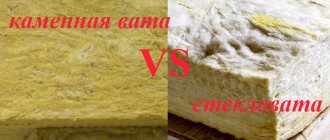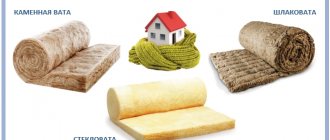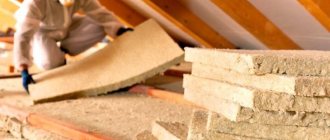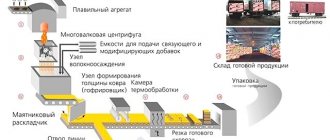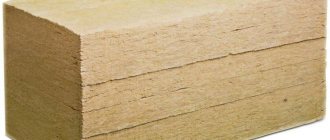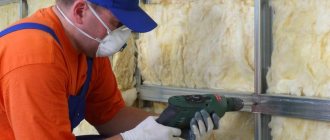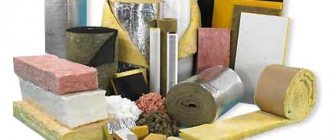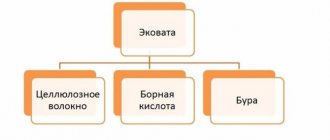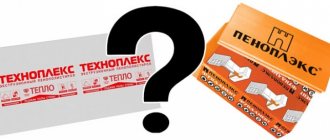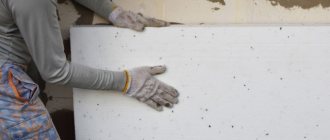In order for a house to be comfortable to live in, it must have high-quality insulation. A variety of materials can be used for it, but most often basalt or mineral wool is used for these purposes. They are similar in some properties. Therefore, in order to make an informed choice, it is necessary to understand: when basalt wool or mineral wool is used, which is better and why.
Mineral insulation in a roll Source tproekt.com
Basalt wool
To prepare it, the stone is crushed until small particles are obtained. They need to be heated to such a high temperature that they begin to melt. From this mass thin threads are made, on the basis of which cotton wool is created. The raw material for production is basalt, which is a volcanic rock.
Slag fiber in a roll Source tproekt.com
General Tips
A few rules and notes for quality work.
Without the correct selection and use of glue, the insulation may sag and cease to act effectively. Stone wool is a rather unusual material, and not every adhesive can provide high-quality adhesion to the wall.
Polymer-cement compositions will provide the highest adhesion. They are sold as a dry mixture similar to cement. There are several well-known brands: “EK THERMEX”, “ERESIT CT190”, “ERESIT CT180”.
Following the instructions on the package, dilute the mixture with water and mix well (repeat after 5 minutes). The solution will retain its adhesive properties for 2 hours.
Apply the solution evenly onto a flat surface of the wall so that you get 7-8 glue circles. We also apply glue to the back side of the cotton wool (closer to the edges); the surface should be covered with the composition more than half. It is also better to coat the joints. The glue hardens for some time, so it is possible to lay the slab correctly. Attaching stone wool to a wall is simple.
Sometimes, for greater reliability, additional fastening may be required. Anchor bolts or slats secured to the sheathing can help here.
Video description
Mineral wool or stone wool?
Mineral wool is also produced from metallurgical slag. In particular, it differs from other varieties in its high tensile strength.
This material has gained popularity when used for various purposes. It is suitable not only for thermal protection of the walls or roof of a house, but also for the installation of high-temperature systems and pipelines. A layer of such material can be used to insulate cabins for insulation and noise protection.
Installation of the insulating layer Source remontami.ru
The difference between stone and mineral insulation
Differences:
- Appearance. Stone wool is produced and released in slabs. The rest are rolls or mats, soft in structure.
- Glass wool is an environmentally friendly product, because phenol solutions, etc. are not used in its production.
- One type of mineral product requires quartz sand in combination with broken glass.
- Type 1 insulation is better protected from water penetration.
- Retains heat better.
- It is much easier to transport to the desired location because it is lightweight.
- There is a low risk of mold formation on stone wool.
- The fibers are in a cross direction. This makes practical sense.
- Stone is not capable of releasing various types of toxins.
Density of stone wool
*
That is, when compared, the first subtype of mineral wool turned out to be more reliable and durable.
The composition includes dolomite, installation adhesive and limestone rock.
At the same time, the service life of both insulation materials is the same - half a century. But with careful use and care, it can last in a person’s home for up to 20 years.
Comparison of materials
Installation is carried out in the same way in both cases. However, it is necessary to take into account the difference between mineral wool and basalt wool.
It should be taken into account that basalt wool has a relatively dense consistency. This makes it more brittle and less elastic. Both materials can be used to insulate horizontal or vertical surfaces. Thermal insulation material may completely or partially lose its properties when exposed to moisture.
Basalt wool can withstand thirty percent wetness with virtually no loss. Since this material does not shrink, it can be used for laying in a screed or placed under plaster.
Mineral wool has less density and weight. It is soft and can absorb liquid well. When installing, it is important to provide this insulation with reliable moisture protection and vapor barrier.
Installation of basalt insulation Source pro-instrymenti.ru
Price list
Insulation of ventilation façade with cladding
| Name | Without insulation | 50mm | 100mm |
| — porcelain stoneware, rub/m2 | 3045 | 3330 | 3440 |
| — fiber cement panels, rub/m2 | 3175 | 3460 | 3570 |
| — metal cassettes, rub/m2 | 3415 | 3700 | 3810 |
| — Clinker tiles, rub/m2 | 5245 | 5530 | 5640 |
| — Aluminum cassettes, rub/m2 | 6860 | 7145 | 7255 |
| — Planken, rub/m2 | 4815 | 5100 | 5210 |
| — Composite cassettes, rub/m2 | 3520 | 3805 | 3915 |
| — Metal siding, rub/m2 | 2715 | 3000 | 3110 |
| — Profiled sheet, rub/m2 | 2215 | 2500 | 2610 |
| — Terracotta panels, rub/m2 | 7815 | 8100 | 8210 |
| — HPL panels, rub/m2 | 6860 | 7145 | 7255 |
| — Natural stone, rub/m2 | 6090 | 6375 | 6485 |
| Name / thickness of thermal insulation | 60mm | 80mm | 100mm |
| Turnkey installation of thermal panels lined with artificial stone, rub/m2 | 3300 | 3450 | 3550 |
Video description
Basalt wool or mineral wool: comparison of insulation.
Mineral wool is more convenient in this regard. Its fibers are relatively long, soft and durable. This material produces virtually no dust and is more environmentally friendly.
What these materials have in common is that they are both non-flammable. It is believed that these types of insulation are not susceptible to attacks by rodents or pests. If moisture penetrates inside, it will not lead to rotting or fungus formation. The thermal insulation properties of both materials are approximately the same.
Installation of roof insulation Source pulscen.ru
Thermal conductivity
Thermal conductivity is the ability of a material to transfer thermal energy from a warm part of the material to a colder part. When it comes to insulating walls or floors, the lower the indicator, the longer the external cold will not be able to penetrate the room, and therefore heating costs will be reduced. In the summer heat, thermal conductivity has the opposite effect and helps keep the inside of the house cool.
Due to its fibrous structure, heat transfer through mineral wool depends on the thickness of the threads. Glass wool with fibers of 5-15 microns has a thermal conductivity index of 0.038-0.046 W/(m*K). And basalt wool, with fibers with a cross-section of 3-5 microns, begins its minimum value from 0.033 W/(m*K). Since insulation made from a basalt base has thinner threads, heat transfer through them takes longer, which makes it a leader in this characteristic.
Usage
The main use is to provide thermal insulation. In this sense, the materials have approximately the same characteristics. There are differences, but they are minor.
These materials can also be used for sound insulation. This plays an important role, for example, where there is heavy traffic or in apartment buildings with good audibility.
Insulation of facades with slabs Source vitebsk.pulscen.by
Some designs use the load-bearing properties of the materials in question. An example is inversion roofs. In this case, the density and elasticity of the material play an important role.
Both basalt and mineral wool have a high degree of fire protection. If they get caught in a fire, the fibers will not burn, but will bake. Some other insulation materials are significantly inferior in such characteristics, being flammable materials. For example, this applies to polystyrene foam.
Differences between stone and mineral
When people tell us about mineral wool, we don’t understand what it is. To make it easier for people to understand, in everyday life it is called, oddly enough, glass wool. That is, the basis is a material that is extracted from mineral rocks, has excellent sound insulation, thermal insulation and consists of small fibers.
Kinds:
- Glass wool.
- Stone wool.
- Slag-like.
After considering the types of minerals, the question of which is better disappears, because the basis is the same, but the production technique is different. It's worth looking into.
They differ from each other mainly in the composition and content of raw materials.
Large-scale production of this type uses rocks such as basalt. They are crushed into small parts, taken to production, heated to the melting point (1000 degrees). The resulting liquid mass is blown, and after cooling, small fibers are obtained. Next, to convert it into the final product, the liquid is combined with a solution of phenol-formaldehyde. The end result should be slabs that resemble cotton wool, but are more structured.
Fiber Density
*
Mineral raw materials:
- Broken glass and quartz sand. To glue the material, no resinous substances are required. Disadvantages - it crumbles during installation, can get into the lungs, there is a possibility that sharp parts will damage the skin, it is problematic to use.
- Waste from the metallurgical industry. Made from clay and carbonate that reacts with potassium. Disadvantages - cannot be used at home, as it is toxic and causes unnatural reactions of the body (allergies, general deterioration of health).
- Basalt insulation. Made from environmentally friendly materials and does not harm health. It is the most popular for insulating roof structures.
Also, for the production of subspecies - glass wool and slag wool, quartz sand and residues from broken glass in production are melted, less often full glass.
Mineral wool rolls
What to choose
At first glance, both materials are of equal quality. However, when choosing, you need to take into account the characteristics of a particular situation and how basalt wool differs from mineral wool. To determine which material is best, you need to pay attention to the following:
- You need to decide why exactly these materials are being purchased. They may be required not only to insulate a house, but also to protect pipelines, sewers, and underground tanks.
- If you need the material to provide protection from rodents, then glass wool is better suited in this regard. This feature will be useful, for example. When insulating basements or basements.
- If an insulator is required for noise protection, then a layer of glass wool is better suited.
- When insulating walls and roofs, the ability of basalt wool not to shrink is useful.
- Slag wool is the most vulnerable material among those presented to moisture. When working with it in conditions of high humidity, it is advisable to avoid direct contact with the metal. Otherwise, this may cause the development of corrosion processes.
- Basalt slabs have higher protection from moisture. They are practically not exposed to it and absorb it poorly.
The right material will allow you to create a comfortable and cozy home.
Insulation of facades with slabs Source vitebsk.pulscen.by
Water absorption
If there is a possibility that the structure in which the insulation is embedded may come into contact with water, then the water absorption indicator is important, indicating how quickly the insulating layer will get wet. When wet, its properties deteriorate significantly, so when choosing insulation for entrance doors or filling walls in a bathhouse, you should give this priority attention.
The water absorption of glass wool is 1.7% by weight after 24 hours of direct contact with water. Basalt slabs have a value of 0.095%, making it twice as good in this category.
Carrying out work
Creating a thermal insulation layer requires following general rules. Regardless of the characteristics of a particular material, it is necessary to create conditions for its most effective use. The following must be taken into account:
- Although different types have different resistance to moisture, it is necessary to provide adequate protection for them. It is important to understand that, for example, if rain wets the thermal insulation layer of the roof, it will cease to perform its functions. A similar situation arose when groundwater entered the layer protecting the basement.
- If moisture has already gotten inside, you need to create the opportunity for ventilation and vapor barrier. Under such conditions, the liquid will gradually evaporate, ensuring the normal functionality of the protective layer.
- Although the material is often considered to be well protected from rodents and insects, it is nevertheless better to take additional measures to ensure this.
- In the production of basalt or mineral wool, special chemical compounds are used. During production, safety measures are observed to ensure the harmlessness of the material. However, you need to understand that there are different technological processes and in some cases you cannot be sure of 100% environmental friendliness. Therefore, when installing a layer, you need to ensure that it is well closed.
- During operation, dust may be generated to varying degrees, which can be harmful to health. This is due to the fragility of the fibers. Therefore, it is important to ensure that the wool layer is sealed tightly.
- In conditions of high humidity and for outdoor work, it is beneficial to use basalt wool. It will be more effective due to good mechanical strength and relatively high moisture resistance. To secure it, you can use a lathing or use special dowels with a wide head instead.
- If you need a material that will have to be used in conditions of strong heating, then it is more profitable to use basalt wool. This is due to increased resistance to temperature effects and the fact that no harmful substances are released when heated.
- If the materials in question are used to insulate areas of complex configuration and high-quality insulation cannot be counted on, it is necessary to ensure that the safest material in this regard is used.
How to glue mineral wool?
How to glue mineral wool? It is important that there is no air movement under the layers of mineral wool, because... this may reduce its thermal insulation capabilities. Therefore, it is necessary to fix it tightly. Adhesive compositions will help with this. Adhesive compositions that can be used with mineral wool are dry mixtures and foams.
Moreover, foams are more convenient to use; foam allows you to avoid smearing on the surface of the waterproofing.
